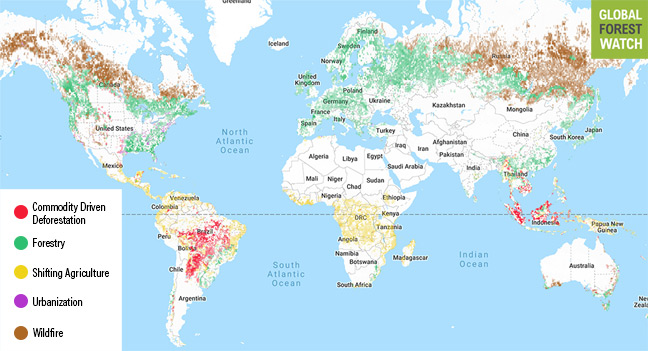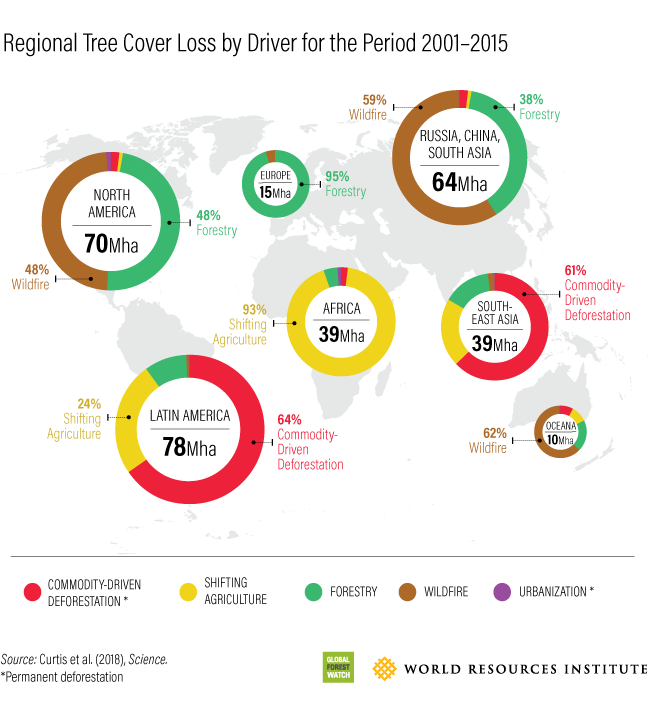, , and
The narrative is not a new one: The world is losing tree cover at an alarming rate, and the effects on biodiversity, the climate and indigenous communities cannot be overstated.
The question is, why? What’s causing this loss? And will tree cover come back, or will the land be used for a new purpose? Our new study, released today in Science, gets us one step closer to answering these questions.
Together with The Sustainability Consortium and the University of Maryland, we visually interpreted thousands of satellite images in Google Earth to identify what caused forest disturbance around the world. We used this information to train a computer model to determine the most likely drivers of tree cover loss that was detected globally between 2001 and 2015. Starting today, the map is available on Global Forest Watch.
Five drivers of tree cover loss are shown. Understanding the implications of each of these drivers helps provide more context about the status of global forests.


Commodity-driven Deforestation: 27 percent
Commodity-driven deforestation was the dominant driver associated with 27 percent of gross global tree cover loss between 2001 and 2015, equivalent to a deforested area approximately a quarter the size of India. This type of loss exemplifies the definition of deforestation, as it reflects a permanent conversion of forest cover into something else. In this class, trees are cut down to make way for activities like agriculture, mining, and oil and gas production. We see the most commodity-driven deforestation in the tropical forests of Latin America and Southeast Asia.
Hundreds of companies have publicly committed to sustainable production and sourcing of global commodities like palm oil, soy, beef, and gold. For the first time, we can quantify how much deforestation is due to commodity production and evaluate the collective impact of those commitments. Our results show that there is still much work to be done; commodity production is responsible for an average of five million hectares of deforestation per year.

Shifting Agriculture: 24 percent
In tropical regions, local communities practice traditional shifting agriculture in which land is cleared and burned for short-term cultivation of subsistence crops. After harvesting, the land is left to allow forests to regenerate. This and other forms of small-scale, mosaic agriculture were the dominant drivers associated with 24 percent of global tree cover loss.
The impact and permanence of tree cover loss due to shifting agriculture varies from place to place and therefore the level of permanence associated with tree cover loss in these landscapes is less straightforward to determine than for commodity-driven deforestation. In parts of Peru, shifting cultivation cycles are well-managed and contribute to a stable mosaic landscape of agriculture and regenerated forest. In other areas, such as in Democratic Republic of the Congo, rapid population growth is intensifying pressure on land, leading to shorter fallow periods, reduced opportunities for forest regeneration, and long-term forest degradation. Expansion of mosaic landscapes can also come at the cost of intact primary forests, which provide special value for biodiversity and carbon storage.
Urbanization: 0.6 percent
The expansion and intensification of urban centers was the dominant driver associated with a very small fraction (0.6 percent) of loss globally. More than two-thirds of this loss was in the eastern United States. Trees in and around cities contribute to clean air and drinking water and the regulation of stormwater runoff and urban flooding. Loss of tree cover is likely to lead to significant economic impacts and diminished quality of life for millions of urban dwellers.
Wildfire: 23 percent
Wildfires were the dominant driver associated with 23 percent of global tree cover loss and were concentrated in northern forests of Canada and Russia. Some fires start naturally and are an important part of ecological succession. But others are caused by humans, either directly through intentional or accidental ignition or indirectly through human-induced climate change leading to increased fire frequency. In the United States, wildfire problems are most pronounced in areas where houses and wildland vegetation meet. Forests affected by wildfires typically regenerate gradually over time, but extreme fires, often exacerbated by climate change, can have a lasting effect on wildlife habitat, carbon storage and the landscape’s natural fire cycle.
Forestry: 26 percent
Forestry was the dominant driver associated with 26 percent of global tree cover loss between 2001 and 2015, concentrated in the natural forests and tree plantations of North America, Europe, Russia, China, southern Brazil, Chile, South Africa and Australia. In most cases, this tree cover loss is a temporary phenomenon related to the planned harvesting and regrowing of trees to supply wood products. Certification has arisen as one mechanism to ensure that tree harvesting and regrowing cycles are well-managed, resulting in a sustainable long-term supply of wood products among other social and environmental benefits.
Our analysis suggests that annual harvest cycles on average affect less than 1 percent of the total tree cover in areas dominated by forestry. Currently, certification is mainly seen in the northern hemisphere, and the costs of effective monitoring and auditing are a key barrier for certification in the tropics.
Towards a More Complete Picture
Since 2014, Global Forest Watch has provided timely and transparent data on annual tree cover loss, empowering users with actionable insights about where and when loss is happening around the world. Today the platform moved one step closer to explaining why this loss is occurring—information decision-makers need to develop appropriate solutions.
The analysis shows us that not all tree cover loss is the same, nor deserves the same attention from policymakers and conservationists. Tree cover loss associated with forestry, fires, and shifting agriculture is often temporary if forests are given the opportunity to regenerate. However, forest conversion for mining, oil and gas production, industrial agriculture, and urbanization is typically permanent.
We found that over a quarter of the world’s tree cover loss occurred in areas where commodity production was the dominant driver, particularly in South America and Southeast Asia. This information tells us that the international community must act more urgently to combat deforestation if we are to achieve Sustainable Development Goal 15. Companies can prioritize high-risk jurisdictions in their commodity supply chains, governments can help support the restoration of forest landscapes that have been intensely managed for small-scale agriculture and concerned citizens can help raise the alarm when deforestation threatens important forests.
Credit: https://www.globalforestwatch.org/
Original post: https://blog.globalforestwatch.org/data/when-a-tree-falls-is-it-deforestation
